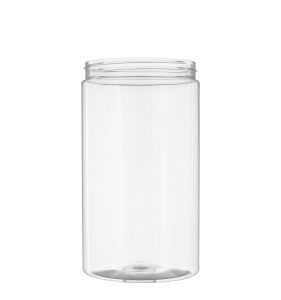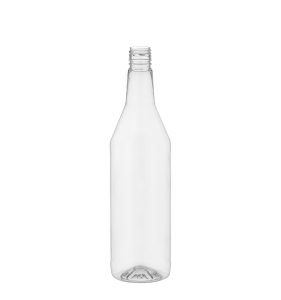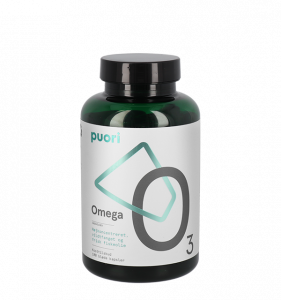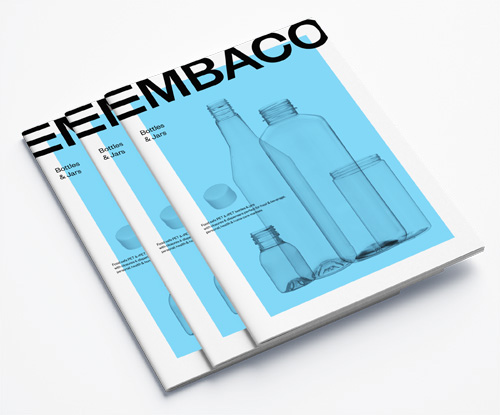PET vs rPET Bottles and Jars: What You Need to Know
Choosing the right packaging materials begins with understanding its effects upon your business, your consumers, and the environment. This article will aim to address these issues as they pertain to the food, beverage, personal, health, and home care markets; demonstrating the features of PET vs rPET to clarify which is the right choice for your products and brand. For further reading, EMBACO has recently commissioned a study which discovered that our rPET bottles reduce CO2 emissions by 82.2%, 3.2% better than market rate.
Key Facts:
- 81% of people felt strongly that companies should help improve the environment *Neilsen’s Global Sustainability Report
- rPET uses 79% fewer greenhouse emissions and less energy than Virgin PET, and has under a quarter of the carbon footprint of Virgin PET
- In the EU, by 2025, production of new bottles should include at least 25% rPET and 90% of all used PET should be collected and reprocessed
- Financial ramifications for businesses that don’t use recycled products are being considered, with taxes being proposed as early as 2022 for all bottles that are not produced with rPET
- There is a limited global supply of rPET currently available, but the growing demand is being met with post-industrial recycling and post-consumer recycling through return bottle schemes
- rPET and PET are both shatterproof, lightweight, EMA and FDA approved, and perfect for bottles and jars for the food, beverages, personal, health, and home care markets
- rPET can have a slight hue due to impurities, but this can be corrected by using a PET mix
- Contact us for all of your rPET or PET packaging needs
The Growing Demand for Sustainable Solutions
Consumers care now more than ever about the impact of their purchases upon the environment. Neilsen’s Global Sustainability Report indicated that, in the US alone, consumers will spend an estimated $150 billion on sustainable products in 2021.
 A Company’s Responsibility
A Company’s Responsibility
Of those surveyed, 73% said they would probably change behaviour to reduce their impact on the environment, and 81% of respondents felt strongly that companies should help improve the environment by implementing programs to this effect.
With large chains like Walmart and Target setting out clear sustainability statements, and many European brands following suit, it’s becoming critical for retailers that the brands they carry help to meet these sustainable goals.
EU Packaging Regulation Changes
Global awareness of ocean pollution and climate change have spurred regulation changes at an international level. Starting with the Single-use plastics directive adopted by all EU member states, which will ensure all packaging contributes as a sustainable part of the circular economy.
It will do this by ensuring a closed-loop process through the two missions set to be achieved before 2025. The first is that the production of new bottles always includes at least 25% rPET. The second is that 90% of all used PET bottles will be collected and reprocessed.
Financial Implications of Non-Recycled Packaging
 There could be considerable financial ramifications involved if sustainability in packaging is ignored. In many countries, governments are considering ways to promote the inclusion of recycled content in plastic packaging, with some looking to tax less sustainable efforts. For example, in the UK a tax was introduced in 2022 for all plastic products that are not produced with at least 30% rPET.
There could be considerable financial ramifications involved if sustainability in packaging is ignored. In many countries, governments are considering ways to promote the inclusion of recycled content in plastic packaging, with some looking to tax less sustainable efforts. For example, in the UK a tax was introduced in 2022 for all plastic products that are not produced with at least 30% rPET.
These developments will have a fascinating impact on the future use and price of rPET as a commodity. It also means it is now impossible to ignore the environmental impact of packaging.
Choosing for Sustainability and Suitability
Sustainable materials are becoming more desirable as consumers consider where the packaging of their products comes from and where it is going. Brands need to be very aware of their environmental impact. Those who don’t could face a consumer backlash or boycott.
These factors combined mean CPG goods manufacturers, suppliers, and brands are facing the increasingly difficult task of having to decide for themselves which materials are more sustainable, high quality, and have the best suitability for their product ranges. Not to mention, are produced and delivered in a more economical and environmentally friendly way.
Are you working within the food, beverage, personal, health, and home care markets? Read on to learn more about PET vs rPET and decide which is right for your products and brand.
Recycled and Recyclable Packaging Impacts Sales
PET and rPET are both either recyclable or recycled, so both are excellent choices. They will resonate with consumers in the current market and have the potential to drive sales, as demonstrated by recent research: Recycled and Recyclable Packaging Resonates with Consumers – Neilsen
What is PET?
PET (or PETE, PETP, PET-P, Virgin PET) is polyethylene (or polythene) terephthalate. A form of polyester. Read more about PET here.
PET Production
It is made by extracting crude oil and processing it into PET granulate that can then be formed into containers such as bottles and jars.
Qualities and Benefits of PET Bottles and Jars
PET is used to make containers, bottles and jars. To learn more about the manufacturing process click here.
The following qualities and benefits of using PET are all valid for rPET, bar one: 100% pure rPET bottles may have a slightly cloudy appearance due to impurities and a lower IV. This could be an acceptable trade-off for consumers, but if not, it can be easily corrected by using a slightly less sustainable mix of rPET and PET.

- Shatterproof
- Good Barrier properties mean a longer shelf-life
- Lightweight, meaning it is convenient to use and incredibly efficient to transport
- Transparent: with the same clarity and appeal as glass packaging to display contents
- Thermostable: most common cold-fill PET bottles and jars can withstand temperatures from -40 to 60degrees
- Reusable, resealable, and fully recyclable: widely accepted by recycling plants across Europe
- More sustainable than other plastics as PET has a lower manufacturing carbon footprint than other plastics
- Customizable: Especially with the Single-Stage injection blow moulding process
- Inexpensive: there is a high supply of PET and so it has a lower cost than other plastics
Read more about the benefits of PET here
What is rPET?
rPET is recycled polyethylene terephthalate. It is made of recycled PET that can come from either Post-consumer or Post-Industrial sources.
rPET Production
The key impact of rPET is in its creation – reducing greenhouse gas emissions by 79%, requiring less energy to produce when compared with Virgin PET. This gives rPET a far smaller carbon footprint, at under a quarter of regular PET, 0.45 of CO2 per kg vs. 2.15 CO2 per kg.
The Benefits of rPET
From a business perspective, introducing more rPET into packaging means a business can identify with a broader customer base and increase sales by meeting the demand for recycled packaging and sustainable efforts. In addition, rPET use leads to greater demand and market for recycled plastics which will increase material supply and lower costs – a win-win for business and the environment.
In addition to having all of the benefits of pure PET bottles – rPET has many environmental gains:
- Uses 79% less energy plus less water to produce than virgin PET

- Reduces transport carbon emissions: as demand grows, there is also a more local and reliable supply of rPET, limiting the need to transport rPET internationally
- Less plastic going to landfill: through recycling and stopping the material entering landfill, no toxic chemicals are leaching into the groundwater during the years that they can take to break down
- Reducing the need to extract resources from the earth, using rPET offsets the need to create new PET
- Encouraging bottle return schemes and post-consumer recycling programs and establishing them as a norm within the industry – less likelihood of plastic waste ending up in the ocean
- Lowering costs – the consumer demand for recycled materials has risen and so is pushing the prices and transport costs down, plus a focus on good design means lowering costs and waste through reducing the amount of plastic used during the bottle and jar production process
- Fulfilling consumer demand for recycled packaging, increasing sales, and lowering costs through progressing the market of recycled materials
PET vs. rPET:
PET and rPET have nearly all of the same qualities, which you decide to use in your business can depend on your brand values, your customer base, their values, and your budget – or re-usability, eco-friendliness and price.
rPET is the clear winner in terms of eco-friendliness – reducing greenhouse gas emissions by 79% when compared with Virgin PET. However, rPET is currently more expensive than PET because high quality granulate is in lower supply.
Both are sustainable, re-usable materials as they are 100% recyclable – however, the quality of rPET can go down with the addition of colours and additives – it can still be downcycled. It is very important to work with competent designers to ensure design and labelling is effective for recycling.
The Role of Design and Labelling in PET Recycling and rPET Production
Bottle and jar design and labelling have a huge impact on how easily a PET or rPET bottle can be recycled and continue through the closed-loop economy. Working with competent designers, aware of the impacts of colour, additives, closure materials, barrier systems, and labelling can mean the difference between a more or less reusable and therefore sustainable product.

“The key principles of the EPBP Design for Recycling Guidelines for PET bottles include:
- Avoid the use of materials and/or components that are known to impede the PET recycling process or reduce the quality of the recycled PET.
- Reduce the amount of non-PET components to allow for ease of separation and efficiency of recycling.
- Design components, such as closures and labels, so that they can easily, safely, cost-effectively, and rapidly be separated and eliminated from the recycled PET.
- The goal of improving the recyclability of PET bottles cannot compromise product safety.”
Source: EPBP Design Guidelines
PET vs. rPET: Summary
With 81% of people feeling strongly that companies should help improve the environment, and significant financial ramifications through taxing of non-recycled plastic use being proposed, it is now more important than ever to ensure your packaging supplier has your business’ and the environment’s best interests in mind.
Both rPET and PET are recycled or fully recyclable, which is resonating strongly with consumers right now. They are also both shatterproof, lightweight, EMA and FDA approved and perfect for food, beverage, personal, health, and home care products. But rPET is a more sustainable solution, with under a quarter of the carbon footprint of Virgin PET.
rPET is currently in limited global supply with a significantly increasing demand. Intelligent producers are introducing post-industrial recycling methods to meet demand and also sourcing PET directly from landfill. There is also an increase in post-consumer recycling efforts through return bottle schemes, subsidised by many governments. This steadily increasing supply means continually lower costs and removal of plastics from landfill, a win-win for businesses and the environment.
Speak with EMBACO today about your PET and rPET bottle and jar production needs.
